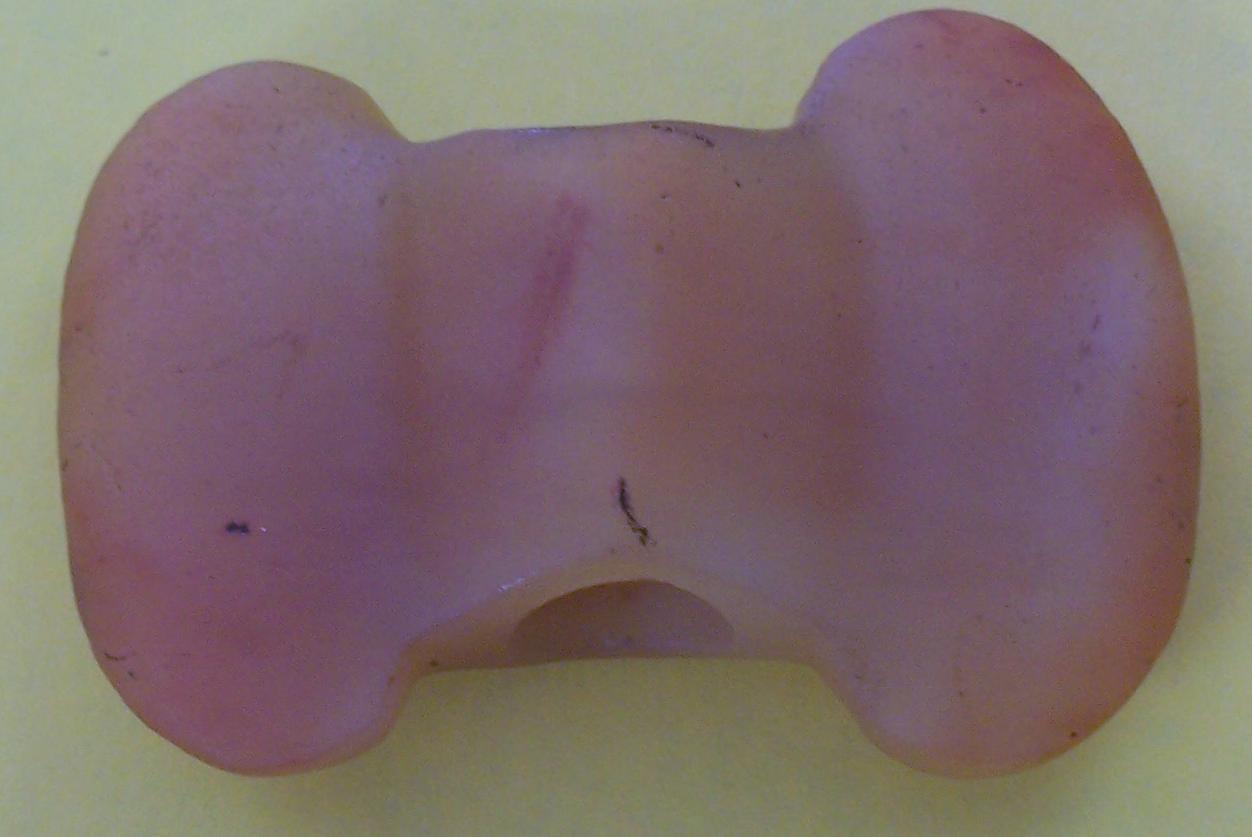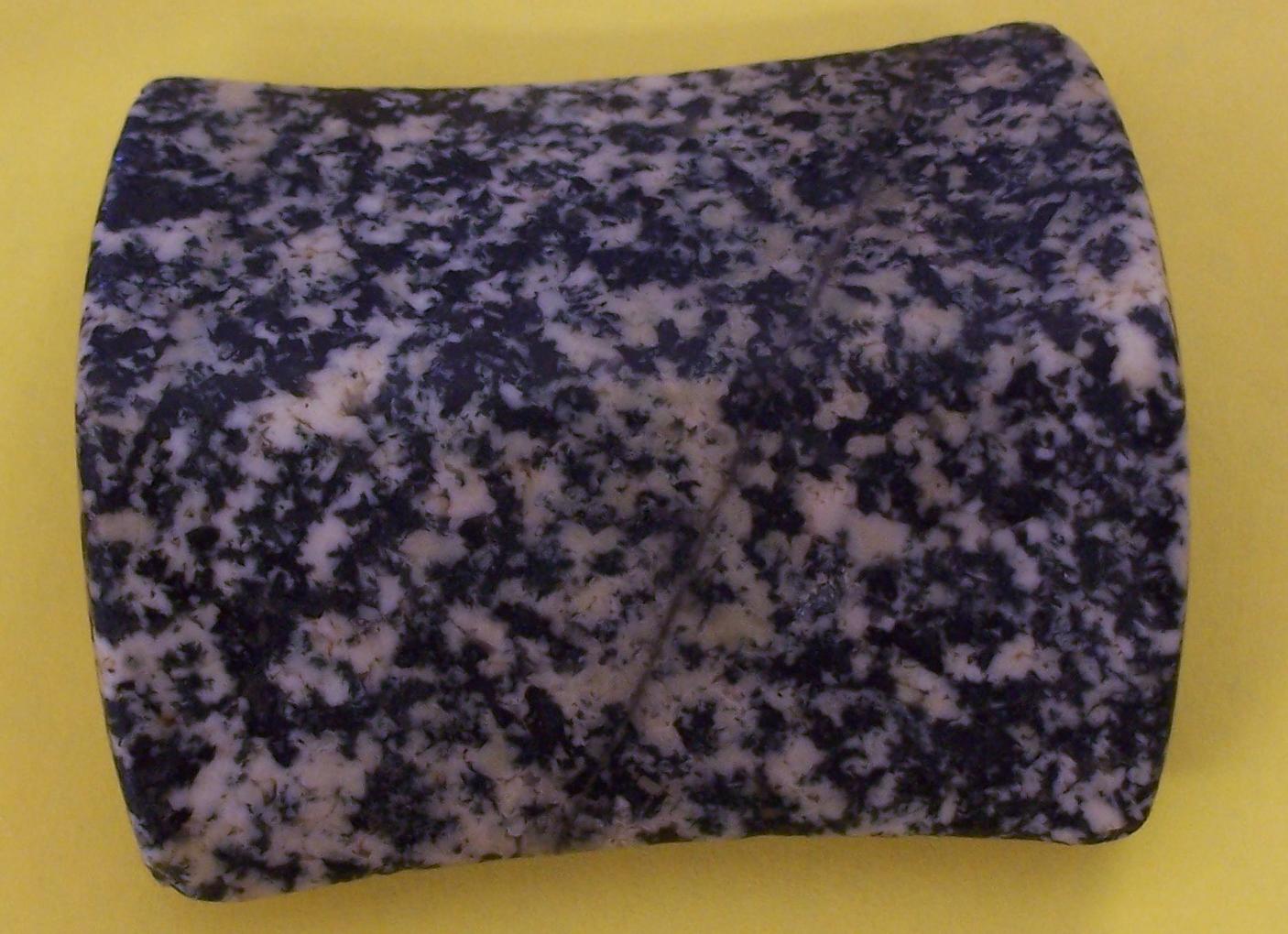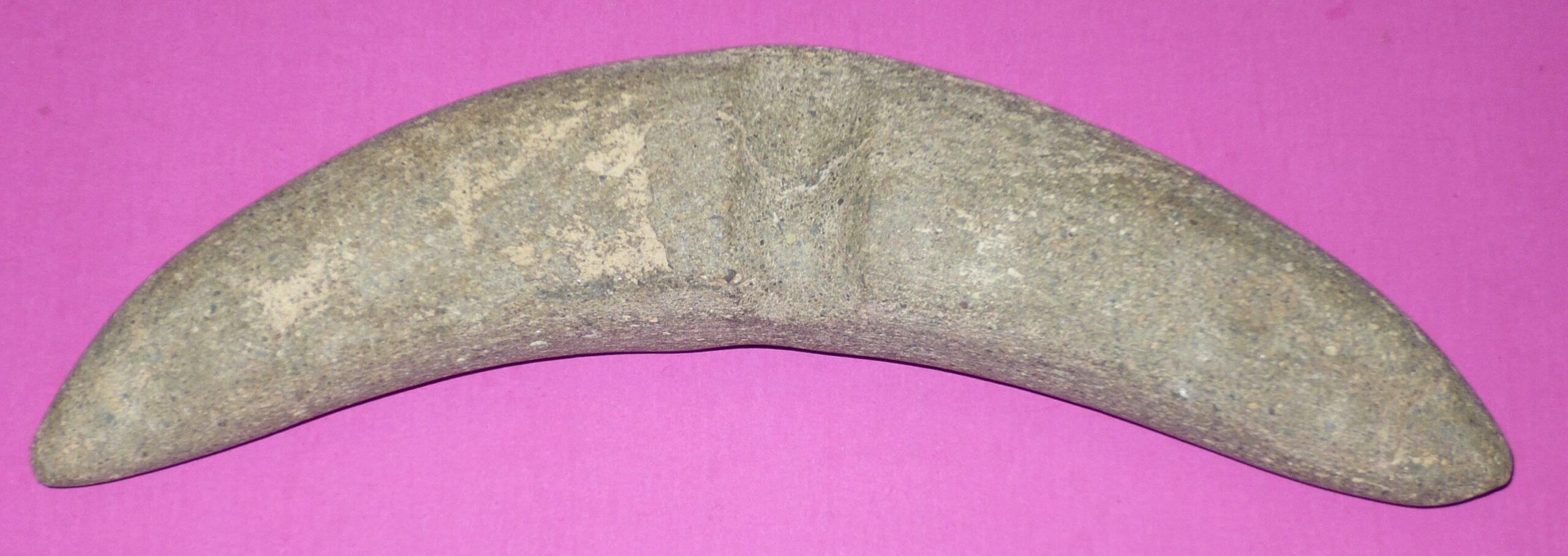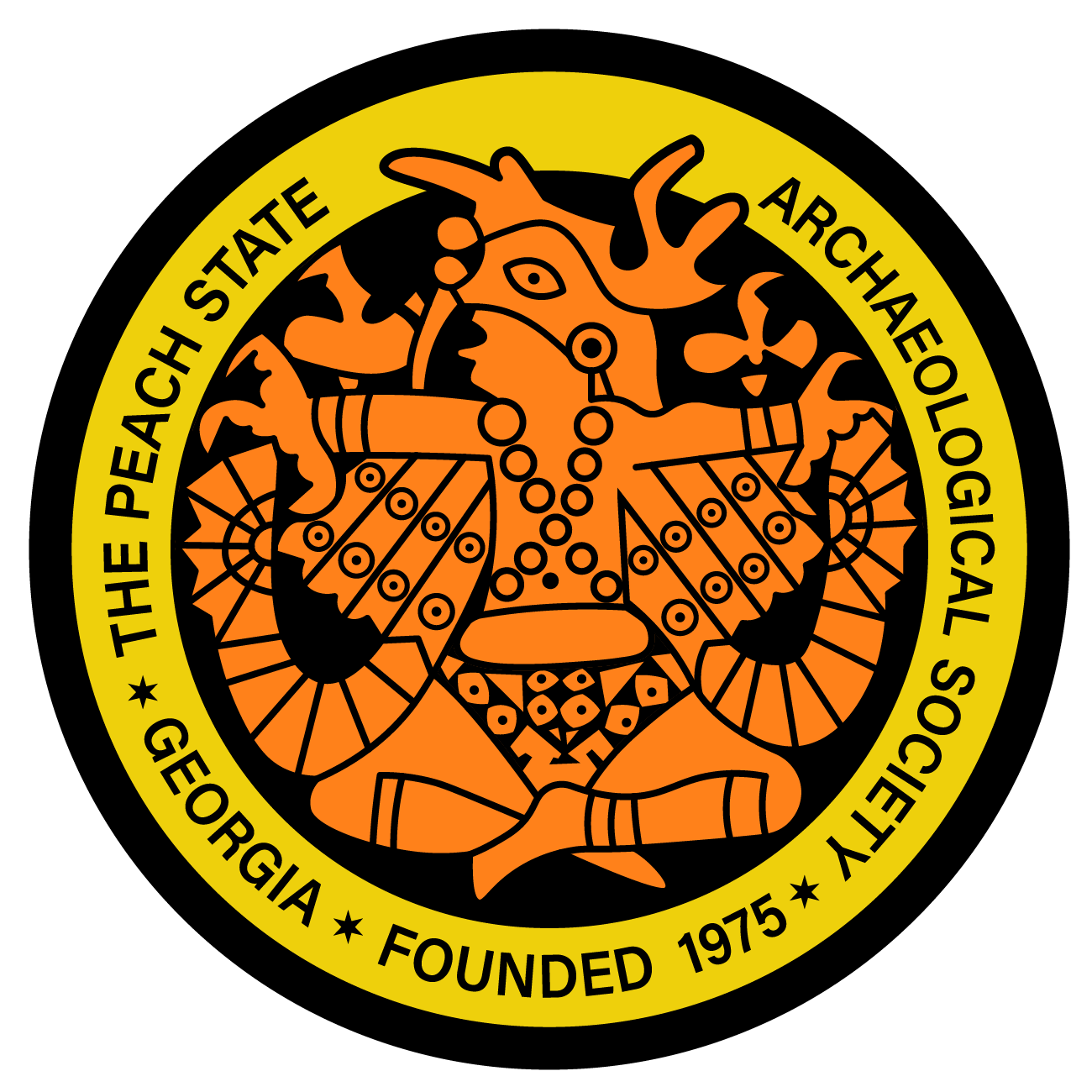Banner Stones
BANNERSTONES

The illustrated atlatl, bannerstone and atlatl hook or trigger were recovered together in an Archaic period context in Davis County, Indiana by Mr. William Miller and are part of a private collection. The handle is made of antler and is bored with a hole that is 1 5/16 inches in diameter to fit the wooden shaft that once served as the atlatl lever. The bannerstone was a simple Humped type. It is made of green banded slate and measures 2.18 inches long and 1 7/16 inches wide. The narrowest part of the drilled hole measures 7/16 of an inch wide and 11/16 of an inch wide at the opening. The hook is made of antler and measurers 2 inches long. This composite tool added distance, force, and accuracy that surpassed the simple javelin as a hunting weapon.
Five or six foot spears or darts can be propelled over 100 miles per hour with a spear thrower. One record long distance throw for a spear or dart was made in 1995 by Dave Ingvall who threw one 848.56 feet, which is almost the length of two football fields. Aztec warriors are reported to have thrown spears or darts completely through the Spanish armor, a feat that would have been impossible without the use of an atlatl.
There are a large variety of bannerstones across the United States, not all of which are illustrated here. We have attempted, rather to provide you with a fair representation of what can be found within the southeastern U.S. We have also not attempted to show all of the variations within each type, but rather to demonstrate the general types as they have appeared within the archaeological record. A very complete record of each type and variation was made by the Tennessee Anthropologist in the Journal of the Tennessee Anthropological Association, Volume VI, Number 2 that was published in the Spring of 1981.
Ball Bannerstones
Richard G. Morgan (Griffin 1952) illustrated Ball bannerstones from the Archaic period in Ohio, but notes its reoccurrence in Kentucky at the Indian Knoll site and at sites in Alabama and Georgia as a Woodland trait of earlier cultures. The Ball Bannerstone seems to fall into at least two subtypes, fluted and round. The drilled central portion does not extend all the way through the stone and appears to fit at the end of the atlatl throwing lever.
Five or six foot spears or darts can be propelled over 100 miles per hour with a spear thrower. One record long distance throw for a spear or dart was made in 1995 by Dave Ingvall who threw one 848.56 feet, which is almost the length of two football fields. Aztec warriors are reported to have thrown spears or darts completely through the Spanish armor, a feat that would have been impossible without the use of an atlatl.
There are a large variety of bannerstones across the United States, not all of which are illustrated here. We have attempted, rather to provide you with a fair representation of what can be found within the southeastern U.S. We have also not attempted to show all of the variations within each type, but rather to demonstrate the general types as they have appeared within the archaeological record. A very complete record of each type and variation was made by the Tennessee Anthropologist in the Journal of the Tennessee Anthropological Association, Volume VI, Number 2 that was published in the Spring of 1981.
*These examples are courtesy of private collectors.
Bottle Bannerstones
Bannerstones were defined by Jerald Ledbetter as polished stone objects that appear in a variety of shapes. The key characteristics are their high quality workmanship, high polish and a central perforation. Bannerstones seem to have served a dual purpose as ceremonial objects and as weights for atlatls, the Aztec name for a throwing lever designed to through long darts rather forcefully for an extended distance. Those that were used for ceremonial purposes or as status symbols were usually larger and more finely made. They were often made from exotic materials like banded slate or the Petoskey stone bannerstone below that is from Bartow County, Georgia. The only place in the world that this stone is found is in the area of the northwestern portion of Michigan’s Lower Peninsula near the city of Petoskey. Bottle bannerstones are so named because of their large, expanded center section that looks like a bottle. This form was more often used for ceremonial or status purposes.
Bannerstones that were used as atlatl weights are most often made of local materials such as quartz, steatite, or malfic lapilli tuff and are most often found broken as they seemed to have undergone great stress in the throwing process. Primitive weapons expert Scott Jones has also stated that bannerstones work very well as counter weights or fly-wheels for pump type drills (see drills).
*The above examples are courtesy of private collectors.
Bottle Bannerstones

The Butterfly bannerstone is one of the most beautiful types with broad wings and a short central tube at the juncture of the wings. These are usually made of various colors of quartz or other brightly colored stones. They are rarely found damaged or broken and probably served more as a status symbol rather than a utilitarian tool. A second form of what is also called a Butterfly bannerstone has the appearance of a butterfly with its wings folded down. Its size is considerable and it is very stylish. This type has more northern roots and is often made of banded slate. It is more commonly found in Ohio and Indiana; however, they have been recovered in Georgia as well.
Concave Bannerstone
The Concave bannerstone is square in its outline, but in cross-section, it is excurvate on one face while the opposite side has a median ridge with two faces that are concave. The banner is drilled through the length of the center with an average bore between approximately ½ and 11/16 inches.
- B. Moore recovered six examples of this type at the Indian Knoll site in Tennessee. Moore recovered several these from burials, possibly in situ as though they were still fastened to the wooden atlatl that had long-since rotted away. He believed these tools to be netting tools; the trigger being the needle and the banner being the net spacer. The atlatl handles, also found in situ were also believed to be antler spacers. Captain J.S. Raybon made a replica net using wooden models of the “spacers” and “needles” to demonstrate their use.
The Indian Knoll site is believed to have been most heavily populated between 3000 and 2000 B.C. More recent sites lay above the main site and evidence is scarce, but other ecological evidence points to this being the most likely period when these burials were dug.
*The above examples are courtesy of private collectors.
Crescent Bannerstones
Lewis and Kneberg (1995) illustrated, but did not discuss the Crescent Bannerstone as one of several types recovered from the archaic sites in the Chickamauga Basin of Tennessee. These are similar in form to the Pick bannerstone, but lack the acute ends. The perforation is central to the bannerstone, but the ends are broad and rounded. The crescent may be singular or double (upper right). Another variation of the Crescent bannerstone is the knobbed crescent, which has knobs of varying sizes at the end of the crescent points.
Hourglass Bannerstones

The Hourglass bannerstone is somewhat square in its outline, but has concave sides on each of its four ridges or along each of its rounded plains. In cross-section, it is concave with flat to rounded ends. The banner is drilled through the length of the center with an average bore of between approximately ½ and 11:16 inches. C.B. Moore recovered at least 17 examples of this type at the Indian Knoll site in Tennessee. He believed these tools to be netting spacers.
The Indian Knoll site is believed to have been most heavily populated between 3000 and 2000 B.C. More recent sites lay above the main site and evidence is scarce, but other ecological evidence points to this being the most likely period when these burials were done.
Humped Bannerstones
A.B. Moore illustrated two examples of the Humped bannerstone from the Indian Knoll site along the Green River in Tennessee. The perforation is central as with all bannerstones, but the tube-like body of the banner has a hump on either one or both sides. This type is not a bottle banner as its midsection is not extreme. It appears more like a Tube banner type. The example at the center (upper row) is an unusual Humped bannerstone from Tennessee and is maintained in the collections of the University of Georgia. The bannerstone at the lower left is a unique form found primarily in northern Mississippi. These are square with a central hole and a hump in the central portion of one side.
The Indian Knoll site is believed to have had its heaviest populations between 3000 and 2000 B.C. and to be a later expression of some of the more northerly archaic cultures. It is at least a very well established period for the Concave and Humped bannerstone types with dates that reflect those of Thornhill Lake in Florida.
*The illustrated bannerstones are courtesy of private collectors and the University of Georgia collections.
Pick Bannerstones
The pick bannerstone is semilunar or pick-shaped and round in cross section and slightly curved. The ends of the banner have a rounded point or, in North Carolina a flattened end. The hole is drilled at the center of the stone with the ends pointing toward the back of the hole. The blanks were roughly flaked or chipped to a general shape, then pecked to their final shape. Examples from the Hardaway site indicate that they were then drilled prior to final grinding and polishing.

Joffre Coe recovered a three unfinished examples of this type of banner at the Stanley level, Zone XI of the Doerschuk site on the Yadkin River in western North Carolina.[i] Stanley points from this period date between 7800 and 7500 years B.P.[ii] Coe also referred to the Pick bannerstone as an “exotic” form also used by the people of the Baden focus in North Carolina between 1000 and 300 B.C., indicating an extensive period of use.
The Indian Knoll site is believed to have been most heavily populated between 3000 and 2000 B.C. More recent sites lay above the main site and evidence is scarce, but other ecological evidence points to this being the most likely period when these burials were done.

One additional variant of crescent pick-shaped bannerstone was reported by Jim Maus as having been recovered in a plowed field near the North Carolina-Virginia border. The bannerstone had the same crescent shape, but instead of having a hole in the center it had a groove on either side of the center.
The Indian Knoll site is believed to have been most heavily populated between 3000 and 2000 B.C. More recent sites lay above the main site and evidence is scarce, but other ecological evidence points to this being the most likely period when these burials were done.
Prismatic Bannerstone
The prismatic bannerstone, sometimes called a Saddle bannerstone, is between 2 and 3 inches in length and is triangular in cross section. The triangular corners are rounded and the ends are flat. The hole is drilled from the flat ends through the stone lengthwise. Joffre Coe referred to this form of bannerstone as one of the “conventional forms” for the Badin focus between 1000 and 300 B.C.

This type of bannerstone was recovered at the Modoc Rock Shelter by Melvin L. Fowler and Howard Winters. The site dated between 4665 and 5325 +/- 300 years B.P. at the 5 to 10 foot level. The site is located in Randolph County, Illinois, but seems to be in line with recoveries in the Southeast.[iii] Jerald Ledbetter recovered an example of this type bannerstone from the Mill Branch site (9WR3), referring to it as an ovoid type. Ledbetter attributed the bannerstones recovered from the Mill Branch sites to the Late Archaic period.
The Indian Knoll site is believed to have been most heavily populated between 3000 and 2000 B.C. More recent sites lay above the main site and evidence is scarce, but other ecological evidence points to this being the most likely period when these burials were done.
Tube Bannerstones

Joseph Caldwell (Griffin 1952) used illustrations by William H. Claflin, Jr. to illustrate the bannerstones from the Savannah River focus along the Savannah River, highlighting the Stallings Island site. The Tube Bannerstone was one of those illustrated. The example on the upper left is the typical style of this type. The example on the upper row (right) is from Baldwin County, Georgia. The unusual style at the lower left was broken and reshaped with holes for tying it to the atlatl. The grooved pedestal is an unusual feature not seen on other bannerstones. The cubic example on the lower right is a Tennessee rectangular Tube bannerstone.
Winged Bannerstone
Jerald Ledbetter recovered a winged type bannerstone at the Mill Branch site (9WR4 South Block). Form and dimensions were estimated by comparison with examples from Stallings Island examples of the same type. Central perforations were estimated at 11 to 12 mm. Bannerstones were drilled by a hollow-cane drilling technique that results in a hole of equal width through the length of the artifact. This drilling procedure produces a long, cylindrical drill core that is often found on the same sites.
Ledbetter attributed the bannerstones recovered from the Mill Branch sites to the Late Archaic period. William H. Claflin, Jr. included this type of bannerstone in his illustration of Savannah River focus bannerstones from Stallings Island. Lewis and Kneberg identified the winged bannerstone as one of two principle types found in the Chickamauga Basin of Tennessee that were recovered from archaic sites. The banner at the far right is from Thornhill Lake Mound in Volusia County, Florida. This is the site of the oldest known burial mound in Florida and dates between 5600 and 4600 B.P. The mound is pre-ceramic and contained only one complete projectile point at its surface, but the mound contained four different types of bannerstones; a Concave Humped banner, a Winged Banner, a Humped banner, a second type of Winged banner, and a Prismatic or Ovoid bannerstone.
*The illustrations above are courtesy of private collectors, Mr. Leon Perry and C.B. Moore.
Rectangular Bannerstones
The fact that Richard S. MacNeish (Griffin 1952) illustrated these “Rectangular” winged bannerstones as part of the artifact inventory from the Brewerton focus of central New York State demonstrates the wide distribution of this and many other types of bannerstones during the pre-ceramic Late Archaic period. This type of bannerstone is essentially a winged banner, but the corners are rather square; almost like a bar of soap.

Lewis and Kneberg identified the rectangular bannerstone as one of two principle types found in the Chickamauga Basin of Tennessee that were recovered from archaic sites.
Half Moon & Other Loaf Stones
The Half Moon loaf stone is a type of atlatl weight like the bannerstone except that, like other loaf stones, it is tied to the atlatl and remains stationary during the throwing process. The example at the upper left has a series of notches that allow it to be wound repeatedly with sinew or some other type of cord. The notches would keep the cords evenly spaced. The bottom side of the stone has no perforations and is flat so that it can be placed against the atlatl handle. The stone at the upper right is a drilled form with a groove that runs along the top ridge of the stone and through the holes drilled through to the bottom of the stone to be tied to the atlatl handle. The loaf stone at the bottom uses this same means of fastening to the atlatl.
The only example of this type of loaf stone that has been recovered and documented was found in a swamp bordering the St. Johns River in Volusia County, Florida. Mr. Albert Turner recovered the artifact near the surface of a Late Archaic shell mound known as Mt. Taylor. The banner had then been shown to C.B. Moore[iv] who recorded it. Moore’s bannerstone was described as a “bird-wing” pattern. It was 4.1 inches in length, 1.4 inches high, and .7 inches thick with a central perforation running from the notched upper margin to the flat, lower margin. It had two peculiarities. One side of the bannerstone was flat while the other side presented two faces that met at a transverse median ridge. The upper margin was deeply notched, similar to the example above (top left) except that the notches were rounded rather than “V” shaped. Secondly, it had two semi-perforations on the side with the transverse ridge, one lower than the other.
The example on the second row was recovered in a plowed field in Bartow County, Georgia. The site contained point types from Early, Middle, and Late Archaic periods as well as a considerable amount of Deptford pottery. When compared to the Florida example found near the surface of Mt. Taylor, dating between 6000 and 4000 B.P., this bannerstone/loaf stone type should be considered part of the Late Archaic period.
These are more typical loaf stones that are made of steatite or sometimes galena and are identified by the grooves in them for tying them onto the atlatl handle. These seem to have followed the use of the bannerstone as a means of adding weight to the atlatl.
*The illustrations above are courtesy of private collectors.
Whatley, John S.
2002 An Overview of Georgia Projectile Points And Selected Cutting Tools, Early Georgia, Vol. 30, No.1
Fowler, Melvin L. and Howard Winters
1956 Modoc Rock Shelter Preliminary Report. Illinois State Museum Report of Investigations, No.4
[iv] Moore, Clarence B.
1898 A Bannerstone of Shell
